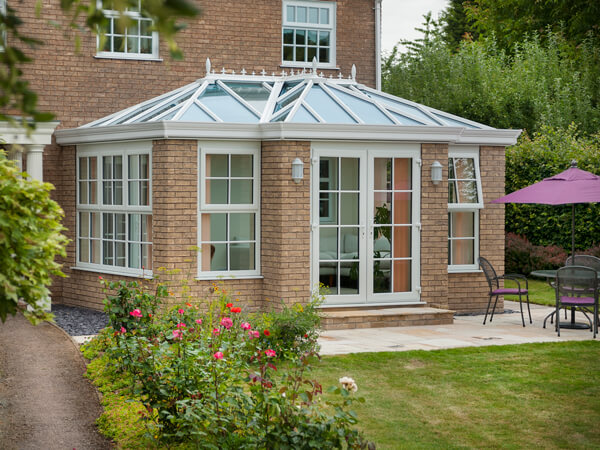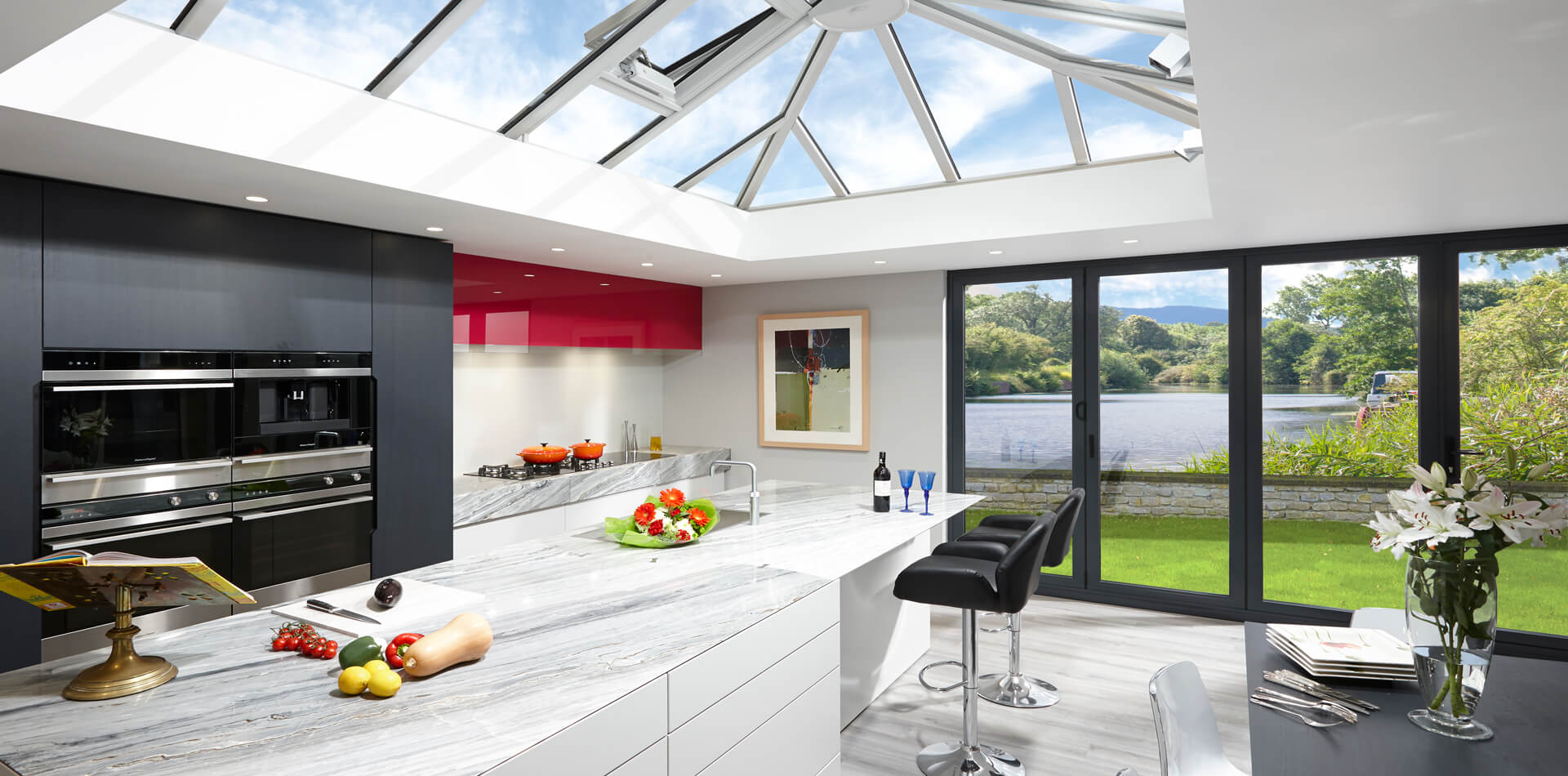Is there any difference between conservatories, orangeries and extensions?
It’s one of the questions that we get asked most and the honest answer is that things are now so blurred that a living space can be anything you want. Tradition shows that a conservatory is predominantly glazed, featuring a glass roof and glass walls, which is great if you want beautiful garden and aerial views. Most modern conservatories now come with a tiled roof and dwarf walls to assure a recipient of enhanced climate control and insulation. You can also have solar control glazing to prevent any overheating and keep the temperature consistent.
An orangery structure includes brick or aluminium pillars, making it an ultra-luxurious space that has a little more privacy to it. There will also normally be a pelmet around the roof of the design for added thermal insulation. The roof on an orangery can be a glass lantern, solid tiled roof or something that combines the two.

A home extension will very much look in character with the house where it’s fitted and be a natural extension of it. Often, it will have some form of solid tiled roof and a high volume of brickwork, giving it a solid feel. Hybrid roofs are typically designed for the modern home extension and incorporate full length glass panels and / or Velux windows for light transference and ventilation. People choose an extension because they know they will get frequent use out of the space and not have it spoiled by the weather.
Does it really matter how they’re labelled? An advisor at any of our Premium Retailers can help you create a one-off extension design.

Shall I ask for a tiled or glass roof?
That will all depend on how the space will be used, the direction it will face and what your budget is. If you most cherish natural light and want a nice view of your garden, we can tell you that solar control glazing is much more advanced nowadays and there are many glazing options that will safeguard the temperature of the design.
If you want it to be a year-round venue, it would be sensible to have a solid tiled roof which can incorporate full length glass panels or Velux windows to give you a hybrid and the many benefits of a solid and glass roof.
A Premium Retailer will be able to help you come to a decision on a roofing system for your extension.

MORE COMMON QUESTIONS
The advisors at all our Premium Retailers are so knowledgeable and can answer your questions. Here are some common questions that are directed to them by customers.
Will the extension get too hot and cold in summer and winter?
We know that this happens a lot with old conservatories, but the living spaces that you can get from your local Retailer are designed for all-year round use and won’t feel like a greenhouse when temperatures soar. Solar control glazing has come on so much in recent years, but if you want a comfortable setting during each season of the year, a tiled roof will likely be a wise choice of covering.
Do you manufacture the roofs yourself?
Not many companies do, but Conservatory Outlet is an exception and regarded as one of the leading roof manufacturers in the UK. The roofing systems are built in our state-of-the-art manufacturing facility, situated in Wakefield, West Yorkshire.
We’re always closely monitoring our production line to ensure our exceptional manufacturing standards never waver and our roofing products are the best they can possibly be.
Can you have different roof tiles so they match my home?
That wouldn’t be a problem. There are many varieties of shingle and slate roof tiles to choose from, and it won’t be difficult for a Premium Retailer to match them to the tiles on your house roof. Flat roof membranes are also included in their roofing range. Get more details for an advisor.
What exactly are ‘A’ rated windows?
An A-rated window is the most energy efficient window that you can currently buy in the UK, as defined by the BFRC Rating Scheme. All replacement windows have an energy efficiency rating and this indicates whether a window complies with building regulations.
For easy identification of the level of energy efficiency offered by a window, it is energy labelled from A-E, in a similar fashion to white goods e.g. washing machines, freezers and fridges).
Knowing the energy efficiency rating of a set of replacement windows helps you to make a more informed choice when searching for a window replacement.
What is solar control glazing?
Solar control glazing has a special coating which stops excess heat from passing into the space and any internal heat from escaping so that it stays comfortable inside. This glass can be tinted if you want to manage the volume of light transmission and heat retention. More information about solar control glazing can be obtained from a Premium Retailer.
Can the brickwork match my existing bricks?
There’s no reason why that wouldn’t be possible. Your local Retailer will do their best to find the closest brick match that they can ahead of the work proceeding. It’s important to know that there can be weathering and manufacturing differences between new and existing bricks. If you’re unhappy with the closest match that they find, it is possible to have the brickwork tinted, but you will have to pay extra for this.
Can you put a sofa in a conservatory?
The answer to this question is yes, a sofa can be placed in a conservatory. In fact, a sofa can be a great addition to a conservatory, providing a comfortable place to relax and enjoy the views of the surrounding outdoor space. However, there are a few factors to consider before adding a sofa to your conservatory.
Can I put a radiator in my conservatory?
When it comes to adding heating to a conservatory, many homeowners wonder whether it’s possible to install a radiator. The short answer is yes, it is possible to put a radiator in a conservatory. However, there are some things to consider before making a decision. Click the link below to explore the pros and cons of adding a radiator to your conservatory.
Can I put underfloor heating in my conservatory?
Underfloor heating is another popular option for heating a conservatory. It provides a more even distribution of heat and can be more efficient than radiators. In this blog post, we’ll explore the pros and cons of installing underfloor heating in a conservatory.
How to keep your conservatory warm?
Keeping a conservatory warm during the colder months can be a challenge, but there are several ways to do so. Click the link below to explore some of the most effective ways to keep your conservatory warm and comfortable all year round.
Can you put plants in your conservatory?
Yes, you can definitely put plants in your conservatory. In fact, a conservatory can be a great place to grow plants as it provides an ideal environment for many types of plants. However, there are a few things to consider when choosing plants for your conservatory.
Is a conservatory cheaper than an extension?
The cost of a conservatory vs. an extension can vary depending on several factors, such as the size, design, and materials used. However, in general, a conservatory is typically less expensive than an extension.
The cost of an extension can range from several thousand to tens of thousands, depending on the size and complexity of the project. In contrast, a conservatory can often be built for less than the cost of an extension, especially if it is a smaller or simpler design. One of the main reasons why conservatories are often less expensive than extensions is that they typically require less building work. Conservatories are usually built on an existing foundation, such as a patio or deck, which can save on excavation and foundation costs. In addition, conservatories often require fewer building materials and less labor than extensions, which can help to keep costs down.
Do you have to have a door between conservatory and house?
Yes, in most cases, you are required to have a door between a conservatory and the main house. Building regulations stipulate that there must be a separating door between a conservatory and the rest of the house, to prevent the spread of fire and to maintain energy efficiency.
There are some exceptions to the requirement for a separating door. For example, if the conservatory is completely open to the rest of the house, such as in the case of a sunroom, a separating door may not be necessary. However, in most cases, it is required by building regulations to have a fire-rated door between a conservatory and the main house.
Can a conservatory have a tiled roof?
Yes, it is possible to have a tiled roof on a conservatory. This type of roof is known as a tiled conservatory roof or solid conservatory roof. It is a popular option for those who want to improve the insulation and energy efficiency of their conservatory, while also creating a more solid and durable structure.
A tiled conservatory roof can be installed on an existing conservatory, or it can be incorporated into the design of a new one. The installation process involves removing the existing glass or polycarbonate roof and replacing it with a tiled roof that is designed to match the existing structure and style of the home.
What is the cheapest way to get a conservatory?
If you’re looking for the lowest cost, always opt for a standard lean-to model, styled in ordinary white UPVC material. These are the cheapest options in overall conservatory design, and with standard door installation (no folding options) and regular double-glazing (no triple-glazing or low-e panes), you can keep costs as low as possible.
What is the biggest conservatory you can get without planning permission?
Adding a conservatory to your home can be a great way to expand your living space and create a connection between your indoor and outdoor areas. However, before you start planning your new conservatory, it’s important to understand the rules and regulations that govern their construction. One of the most important factors to consider is the size of the conservatory, as this can impact whether or not you need planning permission.
What are the new conservatory rules?
The rules and regulations surrounding conservatories in the UK have changed recently, affecting homeowners who are considering adding a conservatory to their property.
Firstly, it’s important to note that planning permission is not usually required for conservatories in the UK, as long as they meet certain criteria. However, even if planning permission is not required, building regulations will still need to be adhered to.
The new rules, which came into effect in 2021, have been put in place to ensure that conservatories are constructed in a safe and energy-efficient way.
What is the 4 year rule for conservatory planning permission?
The 4-year rule for conservatory planning permission is a regulation that allows homeowners to extend their homes without the need for planning permission, as long as certain criteria are met. Let’s take a closer look at what this means for homeowners considering extending with a conservatory.
Under the 4-year rule, homeowners can build a conservatory without planning permission if – click to read more
Will Building Regulations Approval be needed?
When extending a property, you will generally need Building Regulations Approval first. Some extensions are exempt from this though. Things will be clarified by your local Premium Retailer, who will send out a surveyor to your house to assess the proposed project and tell you whether prior approval is likely to be needed. They can also take care of sorting out Planning Permission, speaking directly to your local authority on your behalf.
Do I need planning permission?
Not if the extension can be classed as a Permitted Development. For it to be categorised as such and be exempt from a planning application, it has to meet the following series of limits and conditions:
- The ground area covered by the extension and any other buildings within the boundary of the property, excluding the original house, is not more than half the total area of the property.
- Any part of the extension is not higher than the highest part of the roof of the existing house.
- The eaves of the extension are not higher than the eaves of the existing house.
- Any part of the extension does not extend beyond any wall facing a road if it forms the principal or side elevation of the original house.
- The eaves are no more than 3 metres in height if any part of the extension is within 2 metres of the property boundary.
- The materials used in exterior work, except in the case of a conservatory, are of similar appearance to the existing house.
- An upper floor window on a side elevation within 15 metres of a boundary with another house is obscure glazed; and is non – opening unless the parts which can be opened are more than 1.7 metres above the floor of the room in which the window is installed.
- A side extension does not exceed 4 metres in height or be wider than half the width of the original house.
- In a single storey extension
- the extension does not extend beyond the rear wall of the original house by more than 4 metres for a detached house or 3 metres for any other type of house;
- the height of the extension does not exceed 4 metres;
- no part of the extension is within 3.5 metres of any property boundary with a road opposite the rear wall of the house.
- In an extension with more than one storey
- the extension does not extend beyond the rear wall of the original house by more than 3 metres;
- no part of the extension is within 7 metres of the property boundary opposite the rear wall of the house;
- the roof pitch of the enlargement is as far as practicable the same as that of the original house.
- If you live in a house within a conservation area, World Heritage Site, area of outstanding natural beauty or National Park-
- no part of the exterior of the house is clad with stone, artificial stone, pebbledash, render, timber, plastic or tiles;
- the extension is not more than 1 storey or 4 metres in height;
- no part of the extension extends beyond a principal or side elevation of the original house
How long will it take to construct my living space?
We would hesitate to put an exact timescale on it as it all depends on the complexity of the build. Once your Premium Retailer knows what will be involved and if planning permission and / or building regulations approval is required, they can give you an indication of how long it will take. Ask for a ‘What happens next’ guide which has more details about this topic.
What is a test dig?
A test dig will be performed by the team at your Premium Retailer to determine if the local ground conditions are suitable for a traditional concrete base and foundation. If they find the ground to be unsuitable, they will suggest an alternative foundation proposal, such as a specialist pile foundation or concrete raft.
What is a cavity tray?
A cavity tray is a series of high level damp proof courses that bridge a wall cavity to direct moisture to the external face of a wall where the extension roof joins the house wall. The role of the cavity tray is to stop any moisture that penetrates the outer wall of the extension from becoming visible inside.
Do you offer finance to help me pay for for my new living space?
Yes. To make life easy for you, our Premium Retailers can arrange a variety of affordable and convenient easy payment finance options (subject to application & status). Applying for finance is simple and we promise you a quick decision. Everything can be sorted out with you in the comfort of your home or at your local Premium Retailer Showroom, so you can enjoy whatever you’ve set your heart on right away.
What do we need to do when our finance is approved?
If you’re arranging your own finance, you’ll need to call us as soon as you get the go ahead. If you’re taking up one of our offers, the company will tell us both directly, so there’s no need to call as we will get in touch with you.
What happens if finance is refused?
Finance companies can turn down people for lots of reasons, for example if you’ve moved several times over the past few years. In these circumstances, we always do our best to help and sometimes it’s worth trying another provider, especially if they know you.
I’ve applied for finance with my local Premium Retailer. How long will approval take?
Sometimes our finance company will say ‘yes’ almost immediately and on other occasions it may take them a few days. This short delay can be for any number of reasons and you should not be unduly concerned.
FINANCE OPTIONS AVAILABLE
To make life easy for you, a selection of Premium Retailers can arrange a variety of convenient easy payment finance options (subject to application & affordability). Making an application is simple and we promise you a quick decision. Everything can be sorted out with you in the comfort of your home or in a retail showroom and you should get an answer to your application within 24 hours, so you can enjoy whatever you’ve set your heart on right away.
NEED MORE ANSWERS?
Simply fill in your details below and one of our customer advisors will get in touch to answer any of your questions.



